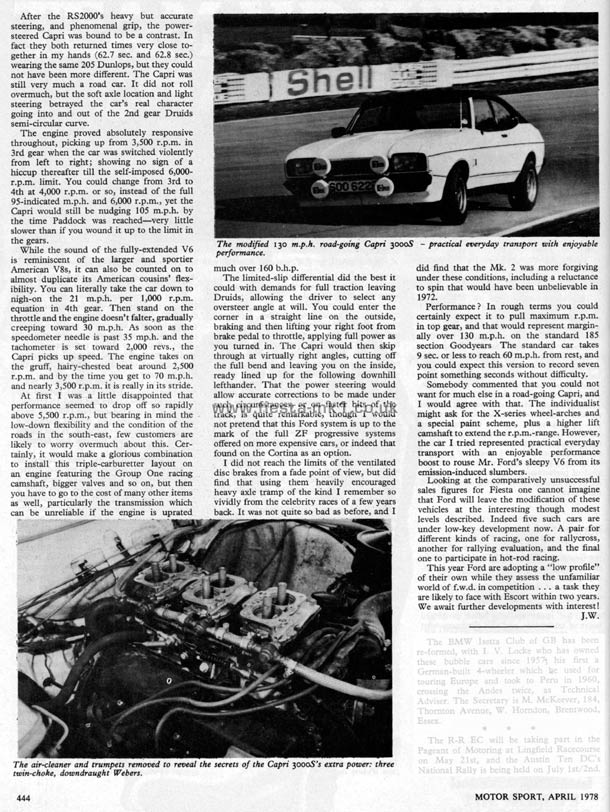Copy of Article Text Below
.....After the RS2000's heavy but accurate steering, and phenomenal grip, the power-steered Capri was bound to be a contrast. In fact they both returned times very close together in my hands (62.7 sec. and 62.8 sec.) wearing the same 205 Dunlops, but they could not have been more different. The Capri was still very much a road car. It did not roll overmuch, but the soft axle location and light steering betrayed the car's real character going into and out of the 2nd gear Druids semi-circular curve.
The engine proved absolutely responsive throughout, picking up from 3,500 r.p.m. in 3rd gear when the car was switched violently from left to right; showing no sign of a hiccup thereafter till the self-imposed 6,000-r.p.m. limit. You could change from 3rd to 4th at 4,000 r.p.m. or so, instead of the full 95-indicated m.p.h. and 6,000 r.p.m., yet the Capri would still be nudging 105 m.p.h. by the time Paddock was reached-very little slower than if you wound it up to the limit in the gears.
While the sound of the fully-extended V6 is reminiscent of the larger and sportier American V8s, it can also be counted on to almost duplicate its American cousins' flexibility. You can literally take the car down to nigh-on the 21 m.p.h. per 1,000 r.p.m. equation in 4th gear. Then stand on the throttle and the engine doesn't falter, gradually creeping toward 30 m.p.h. As soon as the speedometer needle is past 35 mp.h. and the tachometer is set toward 2,000 revs., the Capri picks up speed. The engine takes on the gruff, hairy-chested beat around 2,500 r.p.m. and by the time you get to 70 m.p.h. and nearly 3,500 r.p.m. it is really in its stride.
At first I was a little disappointed that performance seemed to drop off so rapidly above 5,500 r.p.m., but bearing in mind the low-down flexibility and the condition of the roads in the south-east, few customers are likely to worry overmuch about this. Certainly, it would make a glorious combination to install this triple-carburetter layout on an engine featuring the Group One racing camshaft, bigger valves and so on, but then you have to go to the cost of many other items as well, particularly the transmission which can be unreliable if the engine is uprated much over 160 b.h.p.
The limited-slip differential did the best it could with demands for full traction leaving Druids, allowing the driver to select any oversteer angle at will. You could enter the corner in a straight line on the outside, braking and then lifting your right foot from brake pedal to throttle, applying full power as you turned in. The Capri would then skip through at virtually right angles, cutting off the full bend and leaving you on the inside, ready lined up for the following downhill lefthander. That the power steering would allow accurate corrections to be made under such circumstances, or on faster bits of the track, is quite remarkable, though I would not pretend that this Ford system is up to the mark of the full ZF progressive systems offered on more expensive cars, or indeed that found on the Cortina as an option.
I did not reach the limits of the ventilated disc brakes from a fade point of view, but did find that using them heavily encouraged heavy axle tramp of the kind I remember so vividly from the celebrity races of a few years back. It was not quite so bad as before, and I did find that the Mk.2 was more forgiving under these conditions, including a reluctance to spin that would have been unbelievable in 1972.
Performance? In rough terms you could certainly expect it to pull maximum r.p.m. in top gear, and that would represent marginally over 130 m.p.h. on the standard 185 section Goodyears The standard car takes 9 sec. or less to reach 60 m.p.h. from rest, and you could expect this version to record seven point something seconds without difficulty.
Somebody commented that you could not want for much else in a road-going Capri, and I would agree with that. The individualist might ask for the X-series wheel-arches and a special paint scheme, plus a higher lift camshaft to extend the r.p.m.-range. However, the car I tried represented practical everyday transport with an enjoyable performance boost to rouse Mr. Ford's sleepy V6 from its emission-induced slumbers.
Looking at the comparatively unsuccessful sales figures for Fiesta one cannot imagine that Ford will leave the modification of these vehicles at the interesting though modest levels described. Indeed five such cars are under low-key development now. A pair for different kinds of racing, one for rallycross, another for rallying evaluation, and the final one to participate in hot-rod racing.
This year Ford are adopting a "low profile" of their own while they assess the unfamiliar world of f.w.d. in competition ... a task they are likely to face with Escort within two years. We await further developments with interest!
J.W.
Captions -
Top-Right - The modified 130 m.p.h. road-going Capri 3000S - practical everyday transport with enjoyable performance.
Bottom-Left - The air-cleaner and trumpets removed to reveal the secrets of the Capri 3000S's extra power: three twin-choke, downdraught Webers.
|





